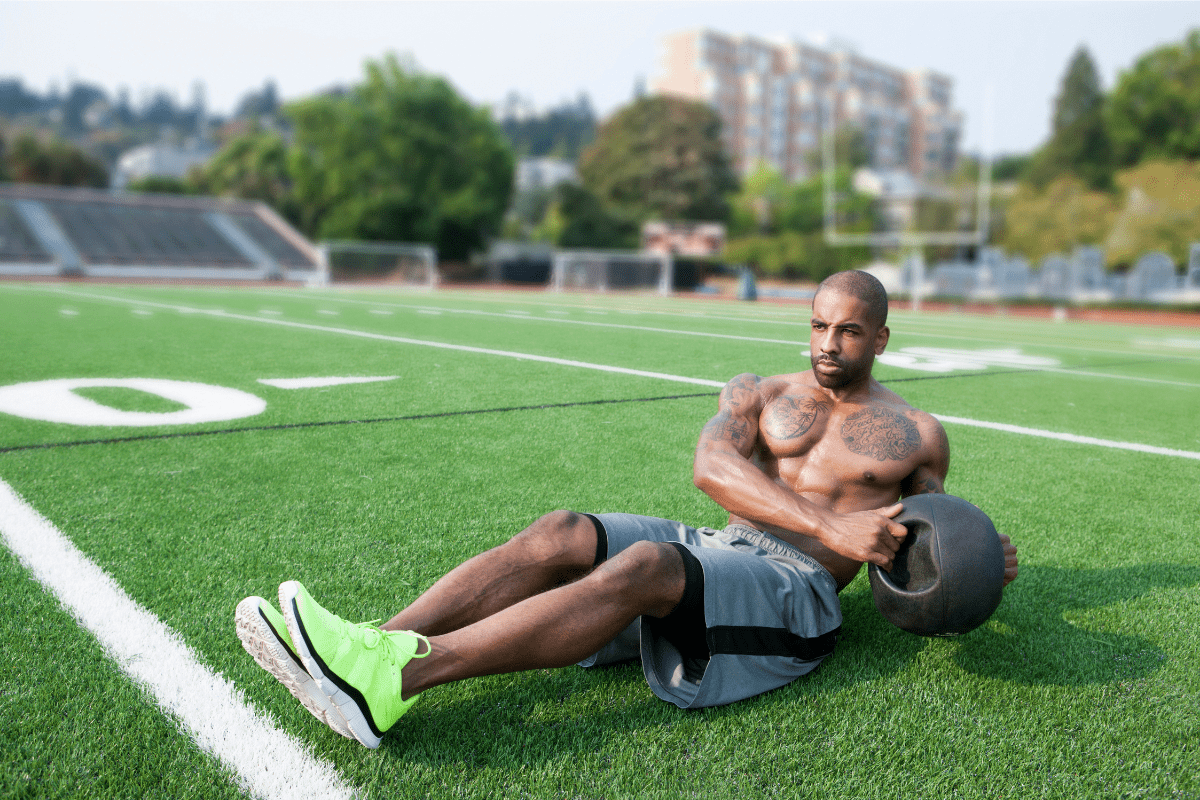Seated Med Ball Twists (How To, Muscles Worked, Benefits)
Seated Med Ball Twists are one of my all-time favorite core exercises. Very few other ab movements can completely cook your core quite as quickly and effectively as Seated Medicine Ball Twists.
In this guide I’m going to teach you how to properly perform Seated Med Ball Twists, explain what muscles they work and give you a few alternatives you can try out.
How To Do Seated Medicine Ball Twists
Equipment Needed
- Medicine Ball
Muscles Worked
- Obliques Externus Abdominis
- Rectus Abdominis
Step-by-Step Instructions
- Start by grabbing a medicine ball and taking a seat on the floor.
- Slightly bend the knees and raise your feet roughly six inches off the floor.
- Start by rotating your torso to the left and lightly tapping the med ball against the ground.
- Now turn your shoulders and rotate your torso to the right and, again, lightly tap the ball against the ground.
- Keep legs mostly still and maintain the feet off the floor throughout the movement.
- Continue rotating back and forth until all reps are completed.
Coaching Points (Common Mistakes)
The biggest mistake I see with my athletes when doing Seated Med Ball Twists is moving the ball back and forth primarily with their arms instead of rotating through the core. The focus should be on the rotation. The ball touching the ground is simply an added bonus to the movement.
Speaking of the ball touching the ground – there is no need to bang the ball off the ground as hard as possible each rep. Stay in control of the movement and the med ball and lightly tap it on the ground.
How Many Reps?
I would suggest 2 to 3 sets of 10 to 15 repetitions.
I generally utilize Medicine Ball Seated Twists as part of a larger med ball core circuit. The circuit will usually be 3 to 4 exercises, two sets of each for a total of around 75 to 100 reps.
Seated Med Ball Twists Variations
If you’re looking to add a little variety to your routine here a couple of simple variations to mix things up a bit.
Weighted Seated Twists
Instead of a Medicine Ball, try using a weight plate for Weighted Seated Twists. This is an easy way to add some extra resistance because most of us will have access to heavier plates than medicine balls. The movement itself stays exactly the same.
Med Ball Twists with Feet on the Floor
For beginners, if Seated Med Ball Twists are a little too difficult, start with placing your feet on the floor. You’ll still get work in for your abs and obliques and once you’re ready you can try to start raising your feet off the floor.
Seated Med Ball Twist Alternatives
If you can’t do Seated Med Ball Twists (or just don’t want to) due to an injury, lack of equipment or whatever else – here are a few alternatives you may be able to substitute.
Lateral Bridges

Lateral Bridges are another one of the favorite core exercises that target the obliques. Start in a Side Plank position and then lower your hips down to the ground and drive them back up.
If you don’t have a medicine ball, Lateral Bridges would be my go-to alternative.
DB Side Bends
If getting down onto the floor is an issue, then DB Side Bends may work as a substitute. You won’t get all the added benefits that holding the seated feet up position brings, but they are a good exercise to target the Obliques.
Oblique Crunches
If you want to keep things simple you can opt for tried and true Oblique Crunches. Lay on your back, place one foot over the opposite knee and crunch across your body. Simple but effective oblique exercise.
More Links and Info
Don’t have a Medicine Ball yet? Before you buy one make sure to check out this article where I compared prices for 24 different popular medicine balls.
If you need ideas and/or instructions for more Core Exercises, head over to the Core Section of my Exercise Library.

